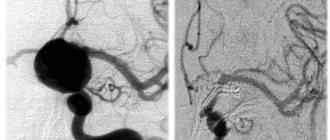Frequent headaches and dizziness can be a consequence of vascular pathologies of the brain. In order to identify them, there are various diagnostic and research methods, one of which is duplex scanning of the vessels of the neck and head.
This method is non-invasive and therefore considered safe. What is especially attractive is that it does not require any special training and has no contraindications.
What is a diagnostic method
This method of vascular diagnostics provides complete information about the state of the human vascular system. Using ultrasound, you can evaluate and analyze the speed and nature of blood flow, as well as determine the presence of blood clots or other vascular pathologies.
The study usually proceeds in two stages: two-dimensional mode and duplex study.
Content:
- What is a diagnostic method
- Why is the procedure necessary?
- What is the difference between duplex and triplex scanning?
- Who needs the procedure
- Preparation for the procedure and contraindications
- How the procedure works
- Advantages and disadvantages of the technique
In two-dimensional mode, you can see the vessels and adjacent tissues, limited only by this information. It does not provide any information about blood supply.
With a duplex study, the doctor sees a complete picture of what is happening in the vessels, with a detailed description and a color two-dimensional picture.
Doppler ultrasound of the main arteries of the head: indications for performing
An ultrasound examination is prescribed by a neurologist for patients who have factors contributing to the development of diseases of the cardiovascular system, as well as during the treatment phase. Ultrasound scanning of the main arteries of the head, the price of which in the neurology clinic is available for patients with various financial capabilities, is performed in the following cases:
- for early diagnosis of thrombophlebitis;
- for thrombosis;
- for varicose veins, diagnosis is especially important in the severe stage of the disease;
- when preparing the patient for surgery to determine the location of the lesion;
- for pathologies of deep veins;
- when a patient is diagnosed with atherosclerosis of the main arteries of the head.
Neurologists at the Yusupov Hospital are attentive to the condition of each patient, therefore, before making a diagnosis, a comprehensive diagnosis and collection of information are carried out. When referring a patient for examination, the specialist explains what a triplex scan of the main arteries of the head shows and what results can be expected.
Why is the procedure necessary?
Unlike simple ultrasound, this diagnostic method provides the most complete information about hard-to-reach vessels of the neck and head. This is especially true of the brain, which is difficult to visualize.
Before the advent of the technique, examining the state of the brain was extremely difficult, if not almost impossible.
Diagnosis was carried out using Doppler ultrasound equipment. The sonographer applied the sensor to problem areas and recorded the sound using a special device.
But it became possible to see what was happening in the vessels of the cervical spine and brain only by using the duplex scanning technique.
MAG research methods
Ultrasound of cerebral vessels can be performed in several modes, each of which allows one to obtain certain information. Often, a patient who has been referred by a neurologist for diagnostics does not fully understand the features of these techniques and the results obtained.
Doppler ultrasound of the main arteries of the head is performed using a sensor operating on the basis of the Doppler effect. In this study, the reflection of sound waves from moving objects is measured, the result is an image of the vessels in 2D mode, which shows problem areas. Doppler sonography is used to determine obstructions and blood flow parameters.
Duplex scanning of the main arteries of the head allows the doctor to obtain information about the anatomy of the vessels, their condition, direction and speed of blood flow. This method is highly informative; it allows you to identify even minor disorders before the appearance of serious symptoms. Triplex scanning of the main arteries of the head is a duplex scanning mode, when using which the doctor receives a color image. The scanning device operates in three modes.
The neurology clinic performs Doppler sonography of the main arteries of the head and other studies. The Yusupov Hospital is equipped with modern equipment, so the research results are as accurate as possible, which helps to successfully verify the diagnosis.
What is the difference between duplex and triplex scanning?
These diagnostic methods are very similar to each other and have practically no differences, with the only difference being that with triplex scanning the vessels can be viewed in three-dimensional space. Duplex mode presents information in only two planes. In fact, triplex scanning is positioned as an additional procedure when conducting a duplex study.
And if we take into account the fact that the crystal transmitting and receiving the signal is the same, then the resolution of the triplex method is considered slightly worse than the duplex one. The quality of the work will depend entirely on the quality of the apparatus and the qualifications of the doctor conducting the research, and not on the diagnostic method.
Triplex scanning MAG in Moscow
A person who is scheduled for diagnosis seeks to find a clinic in close proximity to his home or place of work. If triplex scanning of the main arteries of the head is required, then the Nagornaya metro station is one of the most accessible and convenient for travel.
Near the Nagornaya metro station there is the Yusupov Hospital, which has several clinics, including a neurology clinic. Experienced doctors treat patients with various diseases of the nervous system. To diagnose violations, specialists use modern high-precision equipment. In the neurology clinic, the main arteries of the head are examined using ultrasound machines.
Patients of the clinic can undergo various tests at affordable prices. For the convenience of clients, various options for making an appointment are provided; in addition, you can visit a specialist at a convenient time without a long wait in line. In order to make an appointment with a neurologist and undergo an ultrasound scan of the main arteries of the head, please contact the clinic staff by phone.
Who needs the procedure
Typically, a doctor prescribes such a procedure to a patient if he is diagnosed with: atherosclerosis or endarteritis, thrombophlebitis, thrombosis or vasculitis, aortic aneurysm, diabetic angiopathy, various vascular injuries, varicose veins, vascular anomalies of the head and neck, vertebral artery syndrome.
Such an examination is indicated as screening for asymptomatic diseases and as a control after surgical intervention in the vessels of the circulatory system.
Currently, transcranial duplex scanning of the vessels of the neck and head is considered mainly a technique for studying the vascular system. It is done using ultrasound with color Doppler mapping, as well as through spectral analysis.
The main indications for such an examination are:
- dizziness, severe headaches, migraines;
- increased intracranial pressure;
- deterioration of memory, attention;
- curvature of the spine in the cervical region, hernias in this area;
- hearing loss;
- chronic and acute cerebral ischemia;
- vasculitis and diabetes mellitus;
- vascular pathologies of the brain;
- various brain diseases with identified blood flow disorders after surgery.
Indications for examination of the vascular bed of the head and neck
Ultrasound duplex scanning of those arteries and veins that supply blood to the brain, but are located in the neck (that is, extracranial - outside the cranial cavity) should be carried out in the following cases:
- headache
- dizziness
- unsteadiness of gait
- impaired memory, attention
- coordination problems
- when planning operations on blood vessels and heart muscles
- when identifying pathology of the neck organs, due to which the vessels passing there may be compressed
- visible contraction of the blood vessels of the heart.
Preparation for the procedure and contraindications
This technique is especially popular precisely because it is absolutely harmless and has no contraindications. This procedure can be performed on patients regardless of age: both children and the elderly. You can repeat the manipulation as many times as necessary until the diagnosis is definitely established.
In addition, the diagnostic examination does not require any preliminary preparation. But there are some recommendations that will make this procedure much more effective.
On the day of the examination, stop nicotine and any other substances that to one degree or another affect vascular tone. This::
- coffee;
- energy;
- strong tea.
If you use any medications, such as adaptogens (schisandra chinensis, ginseng, etc.), magnesium, piracetam, vinpocetine, you should first notify the neurologist who prescribed this procedure. Before scanning, you need to get rid of jewelry from your neck and head: earrings, chains, hairpins and others. After the examination, you must wash your hair thoroughly.
Duplex MAG: service price
People diagnosed with stenosing atherosclerosis of the main arteries of the head and other vascular diseases strive to find a clinic that will provide medical care at an affordable price. At the Neurology Clinic of the Yusupov Hospital, the price for diagnostic and therapeutic methods is optimal. In addition, the hospital provides rehabilitation programs for patients who have suffered strokes, suffer from dementia and other diseases.
A beneficial option for the rehabilitation of patients after Alzheimer's disease, Parkinson's disease, stroke, multiple sclerosis are comprehensive programs, including examination by experienced doctors, development of a rehabilitation program and other activities. If necessary, duplex scanning of the main arteries of the head and neck and other studies are performed.
When contacting the Yusupov Hospital, you can be confident in the accuracy of the diagnosis, the quality of treatment, and the friendly attitude of the staff. A personal quality manager helps patients resolve any issues. For the convenience of patients and their relatives, the clinic has created the necessary conditions: the ability to receive medical care 24 hours a day, healthy and tasty food, comfortable rooms with satellite TV and wireless Internet. If you need a triplex scan of the main arteries of the head or a consultation with a neurologist, please contact the clinic staff to make an appointment.
How the procedure works
This diagnostic method is absolutely painless and does not require general or local anesthesia. The patient is examined standing, lying or sitting, depending on which organ needs to be examined.
The surface of the skin is lubricated with a special gel, which facilitates signal transmission. The ultrasound technician then directs the probe to the desired area.
During duplex scanning of the brain, the sensor is placed in places called “ultrasonic windows” - parts of the skull where the bones are thinner or where there are physiological openings in them.
Through such zones, the ultrasound beam easily enters the cranial cavity.
During the procedure, the patient may be required to adopt a more comfortable position for the examination. The doctor may also ask you to hold your breath or do other similar actions. The manipulation lasts approximately half an hour and causes absolutely no discomfort.
Duplex scanning MAG in Moscow
At the neurology clinic of the Yusupov Hospital you can undergo a MAG duplex scan. Diagnostics are carried out using highly informative ultrasound equipment that has sensitive sensors, due to which a specialist can objectively assess the parameters being studied and make a diagnosis based on the information received.
The experience and professionalism of the medical staff of the Yusupov Hospital allows us to successfully diagnose even minor problems and quickly choose tactics for eliminating them, using innovative techniques during therapy and recovery. Doctors at the Neurology Clinic, together with other specialists, provide detailed consultations to patients and their families in an accessible manner. Thus, the patient has information about the state of health, the course of the disease, and risk factors.
MAG duplex scanning in the neurology clinic is performed in accordance with current standards and legislation. The Yusupov Hospital offers affordable prices in the segment of highly informative ultrasound examinations. You can find out the details of the procedure, sign up for a consultation and diagnostics through a special form on the website, after which a clinic employee will contact you to clarify the details or by phone.
Make an appointment
Common advantages and disadvantages of the presented method
Duplex scanning has a number of obvious advantages:
- is highly informative;
- does not require the use of ionizing radiation;
- a cheaper and more accessible research method than alternative ones;
- carried out in real time, does not require waiting for a conclusion;
- helps to reflect the condition of soft tissues that are not sufficiently visualized on x-rays;
- non-invasive, performed without contrast (to which allergies are sometimes found), does not bring any unpleasant sensations;
- Suitable for children and pregnant women.
Any method, along with positive ones, also has negative sides, and in some cases it makes sense to choose other types of research. The decision is made by the doctor on an individual basis, after evaluating the results of other diagnostic procedures and tests, examination, and questioning of the patient.
The disadvantages of the method include:
- difficulty in examining small vessels;
- the possibility of diagnosis only during the research process, and not after it based on the results;
- narrow area to be examined because the bones of the adult skull impede the passage of ultrasound.
An important role in the quality of the diagnostics performed is played by the level of equipment and the professionalism of the doctor. This is one of the diagnostic methods to which increased demands are placed on the professionalism of doctors, so you should choose a clinic for duplex scanning especially carefully, because the result can differ significantly.
What results can you get?
A blood lipid profile test allows you to assess the level of the following indicators:
- Two-dimensional scanning.
A simplified method that allows you to examine vessels and adjacent tissues. This method does not provide a complete clinical picture. - Duplex.
In this case, the equipment creates a two-dimensional color image, allowing for an in-depth study of the vessels.
The principle is based on the fact that ultrasonic waves are reflected from blood cells. This allows you to determine the route and speed of blood movement. The presence of glitches, slowdowns or turbulence indicates damage.
How is duplex scanning of cerebral vessels performed?
On the day of the procedure, the patient is advised not to smoke or drink drinks with high caffeine content. Low-frequency ultrasound will help examine intracranial vessels, and certain zones are used to pass it through the bone structures of the skull. The ultrasound machine sensor is applied to places where the bones are thinner: temples, occipital protuberance, orbital area.
The duration of the scan is up to 40 minutes, the results will be ready immediately after the procedure. In some cases, color triplex scanning is performed, which combines Dopplerography and duplex scanning. The study can be carried out during a migraine attack to assess the sufficiency and symmetry of blood circulation in the brain, to record changes in blood flow speed or differences in blood supply to the hemispheres.
An integrated approach to diagnosis and treatment, consultation on the results of examinations of doctors of various specialties - all this at the Kutuzovsky Children's Center is fast, comfortable and affordable. We are waiting for you every day at the address: Davydkovskaya street, 5.







